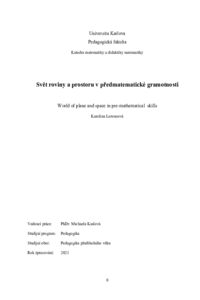Svět roviny a svět prostoru v předmatematické gramotnosti
World of plane and world of space in pre-mathematical literacy
diplomová práce (OBHÁJENO)

Zobrazit/
Trvalý odkaz
http://hdl.handle.net/20.500.11956/152840Identifikátory
SIS: 220891
Kolekce
- Kvalifikační práce [20518]
Autor
Vedoucí práce
Oponent práce
Macháčková, Jana
Fakulta / součást
Pedagogická fakulta
Obor
Pedagogika předškolního věku
Katedra / ústav / klinika
Katedra matematiky a didaktiky matematiky
Datum obhajoby
26. 5. 2021
Nakladatel
Univerzita Karlova, Pedagogická fakultaJazyk
Čeština
Známka
Výborně
Klíčová slova (česky)
prostor, rovina, identifikace objektů, dítě předškolního věku, pojmenování objektůKlíčová slova (anglicky)
Space, plane, identification of 3D objects, preschool child, self named objectsmatikou rozlišování a označování geometrických modelů dětmi ve věku pěti až šesti let. Cílem práce je zjistit děti současné době schopné rozlišit svět roviny a svět prostoru a do jaké míry dětem tyto dva světy splývají. Jsou tři "Děti jsou schopné identifikovat alespoň polovinu prostorových objektů ů stavebnice." "U nadpoloviční většiny dětí dojde k záměně plošných ých objektů." "Děti ři identifikaci některých jim již známých objektů pro ně vymyslí vlastní názvy " ěření použito pozorování a záznamu bylo pořízeno dva tisíce dvě stě dat, která byla podrobena teoretickou částí. všechny tři hypotézy potvrdil. Práce na vzorku sta dětí ukazuje, na jaké úrovni rozlišování a vávání prostorových objektů se v současné době děti předškolního věku v Plzeňském vírá řadu dalších oblastí, kterými je potřeba se zabývat, a řadu otázek, potřeba dále řešit. KLÍČOVÁ SLOVA ů dítě předškolního věku í objektů
The diploma thesis deals with the issue of distinguishing and denominating of geometric models by children aged five to six years. The aim of the work is to find out to what extent children are currently able to distinguish the world of the plane and the world of space and to what extent these two worlds merge for children. There are three hypotheses. H1: "Children are able to identify at least half of objects from a set of spatial bodies selected from a construction set.", hypothesis H2: "More than a half of children are confused naming planar and spatial objects." and hypothesis H3: "When identifying some of the objects familiar to children, they come up with their own names for them." To verify them, quantitative research was used, which also used audio recording to get data and to be able analyze the observed phenomena. The research confirmed all of those three these hypotheses. Two thousand two hundred data were analyzed. The work on a sample of hundred children shows what the level of object distinction and naming them is currently among preschool children in the Pilsen region. It opens up a number of other areas that need to be further addressed and lots of questions to be answered. These include mixing the world of space and the plane. KEYWORDS Space; plane; identification of 3D objects;...
